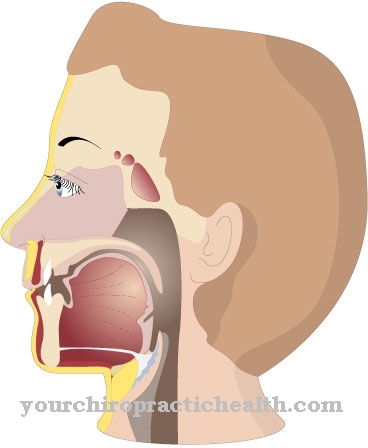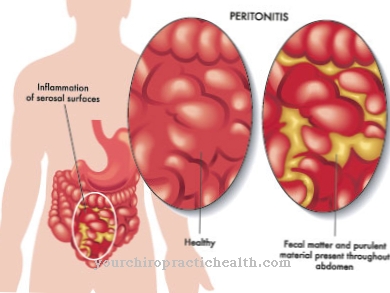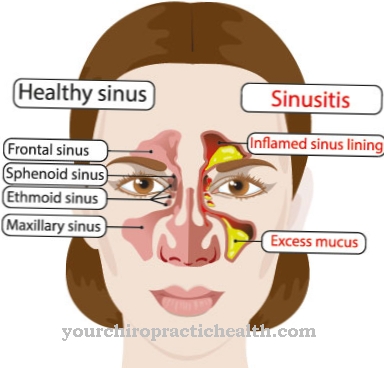The diagnosis Hurler's disease is associated with an enormous psychological as well as physical burden not only for those affected, but also for the parents, as the disease not only has extremely complex, but also serious symptoms. According to the current state of medicine, Hurler's disease is incurable. Those affected have to be treated with a bone marrow or hematopoietic stem cell transplant (BMT) and enzyme replacement therapy as early as infancy or early childhood. This is the only way to pass the years of puberty.
What is Hurler's Disease?

© Adam Ján Figeľ - stock.adobe.com
The diagnosis Hurler's disease defines the most severe form of the lysosomal storage disease mucopolysaccharidosis type I (MPS I). The pediatrician Gertrud Hurler described the course of this rare lysosomal storage disease with skeletal deformations and delayed motor and intellectual development for the first time.The name is derived from your name.
Currently, there is an increasing distinction between MPS I including involvement of the central nervous system (ZMS) and MPS I without involvement. However, the CNS is always involved in Hurler's disease. Fortunately, this disease is very rare. The estimate is around 1: 145,000 births. However, Hurler's disease is the most common at 1: 100,000.
causes
Hurler's disease, too Hurler-Pfaunder syndrome called, is triggered in the IDUA gene by mutations that cause a defect or complete loss of activity of the enzyme alpha-L-iduronidase. The result is an accumulation of glycosaminoglycans (GAG) and a disruption of the cell metabolism.
Due to the enzyme defect, minoglycans can no longer be broken down and broken down sufficiently. Rather, they are stored in the lysosomes of the body's cells. Above all, dermatan sulfate and heparan sulfate accumulate. This severely impairs cell function, creating the symptoms that lead to Hurler's disease.
Symptoms, ailments and signs
The symptoms, the symptoms, are very extensive and usually already in infancy. Short stature and repetitive otitis as well as obstructive and restrictive respiratory problems, often in connection with pulmonary infections, characterize the clinical picture.
Umbilical and inguinal hernias, some of which recur, unilateral or bilateral hip dysplasias as well as a gibbus (pointed hump of the spine) and various joint contractions or joint stiffness are also part of the clinical picture. Compression of the spinal cord in the area of the upper cervical spine (Cervical spine) at the craniocervical junction is also a frequently occurring symptom.
Carpal tunnel syndrome, often bilateral, often occurs in childhood. In the third year of life, the eyes often suffer from corneal opacity, the hearing increasingly develops a hearing impairment and the tongue enlarges (macroglossia). In addition, sleep apnea and mental retardation can occur. The head is relatively large and the lips are not infrequently widened.
Organomegaly (abnormal organ enlargement) as well as hernias and hirsutism (increased androgen-dependent hair growth) can develop. Cardiomyopathy with valve disorder is also frequently observed. A typical appearance can be observed in affected patients. These include a short neck, an enlarged tongue and a deep bridge of the nose.
Growth is usually normal until the age of three. However, development delays can occur between the 12th and 24th months of life. Hydrocephalus can also occur in the 2nd year of life. The growth often ends at a height of 1.20 meters. The gait pattern is also very characteristic due to the malpositions.
Not only the already mentioned enlargement of the tongue, but also a narrowing of the airways and the reduced elasticity of the lung tissue are responsible for restricted breathing. Corneal opacity can progressively affect vision over time.
Diagnosis and course of disease
A diagnosis of Hurler's disease can be made with a [[blood sample] blood test to determine the enzyme activity of alpha-L-iduronidase. A prenatal diagnosis using enzymes and molecular genetics is also possible.
The clinical picture can be divided into three forms because the enzyme defect is based on different mutations. The three gradient forms are:
- Severe Hurler's disease
- Hurler / Sheie's disease (M. Hurler / Scheie) in moderate form
- Scheie's disease (M. Sheie) in mild form
Complications
As a rule, Hurler's disease causes a number of different complaints and complications. The symptoms of this disease limit the everyday life of those affected extremely, so that in most cases they also have to rely on the help of other people or on the help of parents and carers. The quality of life of the person concerned and the parents is also significantly reduced and restricted.
As a rule, the patients suffer from pronounced short stature and breathing difficulties. These can also lead to shortness of breath and in the worst case to death of the patient. The joints are also stiff and usually cannot be moved easily. This leads to restricted mobility and a significant delay in the development of the child.
In most cases, the patient's eyesight and hearing are also discomforts, so that in the worst case scenario, Hurler's disease can cause him to go completely blind or lose his hearing. Furthermore, this disease also leads to retardation, so that the patients are dependent on special support. Unfortunately, the disease itself is not curable, so only a few symptoms can be restricted. In many cases, parents and relatives also need psychological treatment.
When should you go to the doctor?
With Hurler's disease, children already show clear symptoms of the disease. Immediately after discovering the first irregularities, you need medical help, as the symptoms are very detrimental to the patient's quality of life. A visit to a doctor is advisable in the event of breathing difficulties, frequent infections or short stature. If the respiratory function is suspected during night sleep, this should be discussed with a doctor. If there are complications in mobility, there is also cause for concern. Joint stiffness, irregularities in movement sequences and problems with locomotion must be presented to a doctor.
Optical abnormalities or deformations of the skeletal system are signs of a health disorder. If the functionality of the hand is limited or if the cornea becomes cloudy, a doctor is required. A doctor should clarify a reduced development of intellectual skills, a learning disability or developmental disorders of the language.
General growth disorders, a water head, an enlarged tongue or a deep nasal root are characteristic of Hurler's disease and should be presented to a doctor as soon as possible. Normally, the disorders are clearly recognizable from the age of two. A impairment of hearing or eyesight are further indications of an existing disorder and must be examined medically.
Treatment and therapy
Treatment should definitely be carried out by a multidisciplinary team of doctors and therapists. If the central nervous system is affected, treatment as early as possible in the form of a bone marrow or haematopoietic stem cell transplant (BMT) is required. This should be done in toddlers up to 2.5 years of age.
The transplant contains blood cells that produce the enzyme alpha-L-iduronidase. To do this, these cells release part of the formed and intact enzyme into the environment. This is then taken up by other body cells and transported into the lysosomes. The stored glycosaminoglycans can now be broken down again.
Only through a transplant can cognitive development and thus also life expectancy be positively influenced. In addition, enzyme replacement therapy is carried out afterwards. The defective enzyme is replaced by a biotechnologically manufactured form of the human enzyme. Now the pathological storage of glycosaminoglycans can be broken down again.
Due to a blood-brain barrier, however, the enzyme replacement does not reach the central nervous system. As a result, this form of therapy cannot have any influence on cognitive and motor symptoms. As things currently stand, only stem cell transplants can do this. In the run-up to the transplant, the general condition of the patient can be stabilized or improved with enzyme replacement therapy.
It can also support the transplant and alleviate symptoms. BMT cannot cure Hurler's disease. From a purely prognostic point of view, patients with such a therapy can reach early adulthood before they die from cardiovascular and respiratory complications.
Outlook & forecast
The disease is an enormous psychological and physical burden not only for the person affected, but also for parents, because Hurler's disease has not only complex, but also very serious symptoms. According to current knowledge, the disease is not curable. The patients have to be treated with a special bone marrow or stem cell transplant, as well as enzyme replacement therapy, from an early age. This is the only way to extend life beyond puberty.
In most cases, the disease causes a wide variety of complaints and complications. The effects of the disease severely limit the lives of patients, so that they often rely on the help of carers or families. In addition, the quality of life of those affected and their families is significantly reduced and restricted. Often the sick suffer from a very pronounced short stature and have severe breathing difficulties.
These often lead to shortness of breath and in extreme cases to death of the person concerned. In addition, the joints are often stiff and difficult to move without pain. This leads to restricted mobility and severe developmental delays in the affected children. Often there are also problems with the hearing and vision of the patients, so that they can even go completely blind from the disease and lose their hearing.
prevention
Hurler's disease is a congenital genetic defect. Therefore, preventive treatment cannot be used. With a view to genetic engineering, however, the future should be viewed positively.
Aftercare
Hurler's disease is based on a genetic defect and in most cases is severe. Those affected can only contribute to the treatment to a very limited extent. At the beginning of the illness, self-help measures are usually limited to taking advantage of psychotherapeutic offers that can make it easier for the patient to accept the illness.
Self-help groups, in which there is an exchange with other sick people, often help to discover new perspectives in life and to cope with everyday life with this serious illness. A disabled-friendly facility in the living environment allows those affected more freedom of movement. Conversational and behavioral therapies often support the patient's psychological confrontation with the disease.
In the advanced stages of the disease, help from trained nursing staff is often required. Of course, the support of relatives and friends can also have a positive influence on the person's lifestyle. Moderate exercise, the avoidance of psychological stress and a special diet also help to improve the situation.
A complaints diary can help identify unusual symptoms and complaints early on in order to prevent life-threatening complications. Constant communication with the attending physician is essential. In the last stage of the disease, the relief measures are limited to the administration of pain-relieving medication, which must be taken according to a doctor's prescription.
You can do that yourself
Hurler's disease usually takes a severe course and can only be treated to a limited extent by those affected. Accordingly, the most important self-help measure focuses on making use of psychotherapeutic measures. Talking to a therapist, on the one hand, and visiting a self-help group, on the other, offer the sick people opportunities to accept the illness. In addition, a new perspective on life can be developed in conversation with other affected persons.
In addition, steps must be taken to make everyday life easier with the disease. This can be the installation of a disabled-friendly facility, but also behavioral and conversational therapy. People in whom Hurler's disease is already well advanced require care by a specialist. Friends and relatives can be an important support during this time.
The doctor will also recommend actions such as changing diet, exercising, and avoiding stress. This and a complaint diary can lead to a relatively symptom-free life despite illness. The prerequisite for this is that all symptoms and unusual complaints are reported to the doctor. Failure to do so can lead to life-threatening complications that require further treatment. In the final stages of the disease, self-help measures focus on taking the pain relieving medication as directed by the treating physician.

.jpg)


.jpg)












.jpg)







.jpg)


